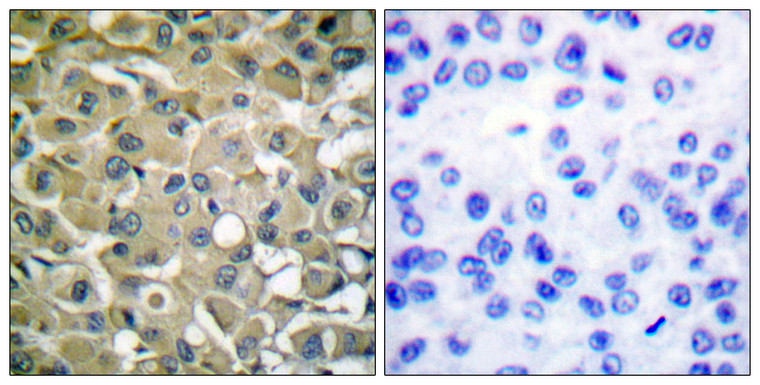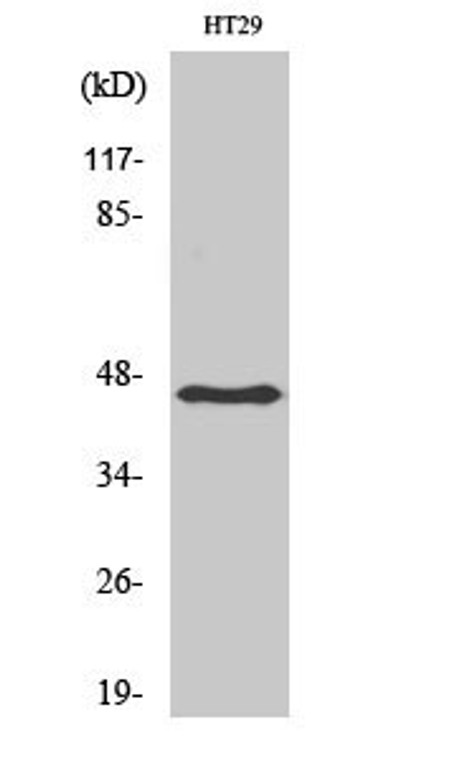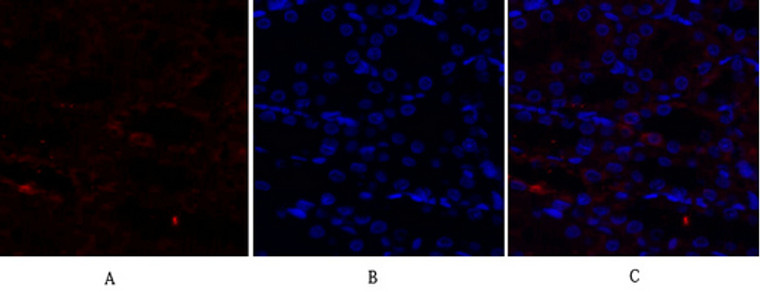-
Western blot analysis of lysates from HeLa cells, treated with UV 5', using Keratin 18 Antibody. The lane on the right is blocked with the synthesized peptide.
-
Immunofluorescence analysis of HeLa cells, using Keratin 18 Antibody. The picture on the right is blocked with the synthesized peptide.
-
Immunohistochemistry analysis of paraffin-embedded human breast carcinoma tissue, using Keratin 18 Antibody. The picture on the right is blocked with the synthesized peptide.
-
Western blot analysis of HT29 cells using Cytokeratin 18 Polyclonal Antibody diluted at 1:2000
-
Immunohistochemical analysis of paraffin-embedded Human breast cancer. Antibody was diluted at 1:100 (4°C overnight). High-pressure and temperature Tris-EDTA, pH8.0 was used for antigen retrieval. Negetive contrl (right) obtaned from antibody was pre-absorbed by immunogen peptide.
-
Immunohistochemical analysis of paraffin-embedded Mouse-colon tissue. 1, CytokeRatin 18 Polyclonal Antibody was diluted at 1:200 (4°C, overnight). 2, Sodium citrate pH 6.0 was used for antibody retrieval (>98°C, 20min). 3, Secondary antibody was diluted at 1:200 (room tempeRature, 30min). Negative control was used by secondary antibody only.
-
Western blot analysis of various cells using Cytokeratin 18 Polyclonal Antibody diluted at 1:2000
-
Immunohistochemical analysis of paraffin-embedded Human-stomach-cancer tissue. 1, CytokeRatin 18 Polyclonal Antibody was diluted at 1:200 (4°C, overnight). 2, Sodium citrate pH 6.0 was used for antibody retrieval (>98°C, 20min). 3, Secondary antibody was diluted at 1:200 (room tempeRature, 30min). Negative control was used by secondary antibody only.
-
Immunohistochemical analysis of paraffin-embedded Rat-brain tissue. 1, CytokeRatin 18 Polyclonal Antibody was diluted at 1:200 (4°C, overnight). 2, Sodium citrate pH 6.0 was used for antibody retrieval (>98°C, 20min). 3, Secondary antibody was diluted at 1:200 (room tempeRature, 30min). Negative control was used by secondary antibody only.
-
Immunofluorescence analysis of mouse-kidney tissue. 1, Cytokeratin 18 Polyclonal Antibody (red) was diluted at 1:200 (4°C, overnight). 2, Cy3 labled Secondary antibody was diluted at 1:300 (room temperature, 50min).3, Picture B: DAPI (blue) 10min. Picture A:Target. Picture B: DAPI. Picture C: merge of A+B
-
Immunohistochemical analysis of paraffin-embedded Human-Tonsil tissue. 1, CytokeRatin 18 Polyclonal Antibody was diluted at 1:200 (4°C, overnight). 2, Sodium citrate pH 6.0 was used for antibody retrieval (>98°C, 20min). 3, Secondary antibody was diluted at 1:200 (room tempeRature, 30min). Negative control was used by secondary antibody only.
-
Immunofluorescence analysis of mouse-kidney tissue. 1, Cytokeratin 18 Polyclonal Antibody (red) was diluted at 1:200 (4°C, overnight). 2, Cy3 labled Secondary antibody was diluted at 1:300 (room temperature, 50min).3, Picture B: DAPI (blue) 10min. Picture A:Target. Picture B: DAPI. Picture C: merge of A+B
-
Immunofluorescence analysis of rat-kidney tissue. 1, Cytokeratin 18 Polyclonal Antibody (red) was diluted at 1:200 (4°C, overnight). 2, Cy3 labled Secondary antibody was diluted at 1:300 (room temperature, 50min).3, Picture B: DAPI (blue) 10min. Picture A:Target. Picture B: DAPI. Picture C: merge of A+B
-
Immunofluorescence analysis of rat-kidney tissue. 1, Cytokeratin 18 Polyclonal Antibody (red) was diluted at 1:200 (4°C, overnight). 2, Cy3 labled Secondary antibody was diluted at 1:300 (room temperature, 50min).3, Picture B: DAPI (blue) 10min. Picture A:Target. Picture B: DAPI. Picture C: merge of A+B
-
Immunofluorescence analysis of rat-lung tissue. 1, Cytokeratin 18 Polyclonal Antibody (red) was diluted at 1:200 (4°C, overnight). 2, Cy3 labled Secondary antibody was diluted at 1:300 (room temperature, 50min).3, Picture B: DAPI (blue) 10min. Picture A:Target. Picture B: DAPI. Picture C: merge of A+B
-
Immunofluorescence analysis of rat-lung tissue. 1, Cytokeratin 18 Polyclonal Antibody (red) was diluted at 1:200 (4°C, overnight). 2, Cy3 labled Secondary antibody was diluted at 1:300 (room temperature, 50min).3, Picture B: DAPI (blue) 10min. Picture A:Target. Picture B: DAPI. Picture C: merge of A+B





















